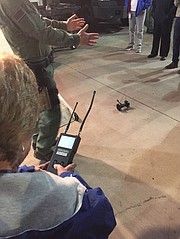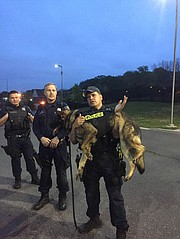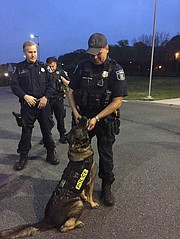The larger mobile surveillance devices, demonstrated by Officer Tim Kyburz, are capable of looking down on a site from two stories height. Photo by Vernon Miles.
The Alexandria Citizens’ Police Academy is a 10-week course hosted by the Alexandria Police Department (APD) to offer citizens a better understanding of how the department works. Throughout the course, participants sit in on emergency calls and ride along with police officers on patrol. In the seventh week of the course, citizens saw the Special Operations Team and K-9 teams in action.
SPECIAL OPERATIONS TEAM
In 1989, a hostage situation was unfolding at 316 Hopkins Court. A man trying to collect on a drug debt had taken hostages at gunpoint inside a house and the Special Operations Team (S.O.T.) was called out to the site in response. The suspect emerged from the house with a sawed off shotgun pressed to the head of a hostage. A police sniper shot and killed the suspect, but not before he’d managed to get off two shots that killed Corporal Charles W. Hill and injured Officer Andrew M. Chelchowski, who died four years later in an apparent suicide connected to psychological trauma from that day. Now, all Alexandria S.O.T. patches bear the number 316, the address of the call, and a reminder of the potential cost.
S.O.T. is responsible for the tactical response for critical incidents. To that end, the team is equipped with a variety of tools and equipment for situation assessment and response. These devices range from the simple, like a two-man battering ram for opening doors, to the high tech, like a range of mobile, remote control camera units that sent live feedback to the S.O.T team in the field.
K-9 UNIT
In the 1980s and ’90s, one of the principles of a K-9 unit was keeping them separate. Though inaccurate, there was a widespread perception of the dogs as vicious tools.
They’re still professional and willing to bite when necessary, but the modern Alexandria Police K-9 is a social animal. Officers don’t just leave them at the headquarters with the rest of the equipment, they’re brought home. They’re part of the family.
“[We] do not select, train, or tolerate nastiness,” said Officer Douglass Serven (K-9: Trajan). “We train them for their nose.”
They’re still working animals, so it’s advised not to approach them and begin petting without the officer’s explicit permission. At $7,000 each, without the cost of training or manpower, the dogs have to be versatile. In addition to the basic patrol school, the dogs can also undergo specialized training for detecting narcotics, bombs, or even to be used in the Special Operations Team.
On patrol, K-9s can be called out to a scene for a variety of reasons, usually tracking or subduing a suspect.
“People would rather fight an officer than a dog,” said Officer Carlos Rolon (K-9: XigXag).
The dogs and the officers go through extensive mental and physical training, after which the two share a lifelong bond. With rare exceptions, a K-9 sticks with its handler for the duration of its service. According to Sergeant Cindy Scott, the officers and the dogs do everything together.
Scott says her K-9, Gage, is slowly approaching retirement. The K-9s are well trained and intelligent animals, and once they retire, they need to continue to be active, otherwise the dogs can become depressed. This can be especially true once the officer takes on a new dog, so Scott says she has to continue to keep her dog involved with amateur sleuthing adventures in the backyard.
In the field, the ability for the dogs to immediately obey the commands of their handler is crucial. Each Wednesday, the dogs and handlers undergo obedience training to test for lapses and response times.
“Obedience is the foundation of everything we do,” said Scott.




